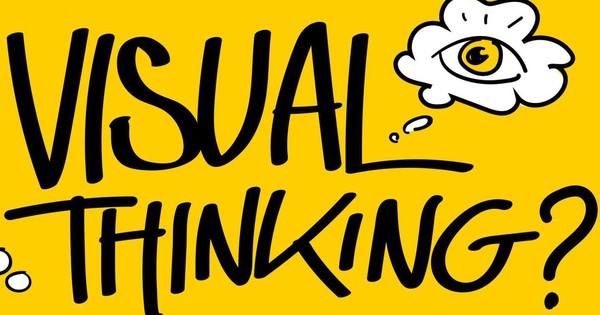In today’s fast-paced world, the ability to process information quickly and efficiently is more important than ever. Visual Thinking offers a unique approach to understanding complex concepts, making it a valuable asset for individuals and organizations alike. But what exactly is Visual Thinking, and why is it gaining so much attention?
What is Visual Thinking?
Visual Thinking is the practice of using visual aids to process information and solve problems. Whether it’s through diagrams, sketches, or mind maps, this approach leverages our brain’s natural inclination towards visual processing. By engaging with information visually, we can enhance our comprehension and retention, leading to more effective learning and communication.
So what is Visual Thinking that has the ability to help people process information so quickly and effectively? The answer lies in the way the brain processes images faster than text, thereby optimizing the absorption and creation of ideas.
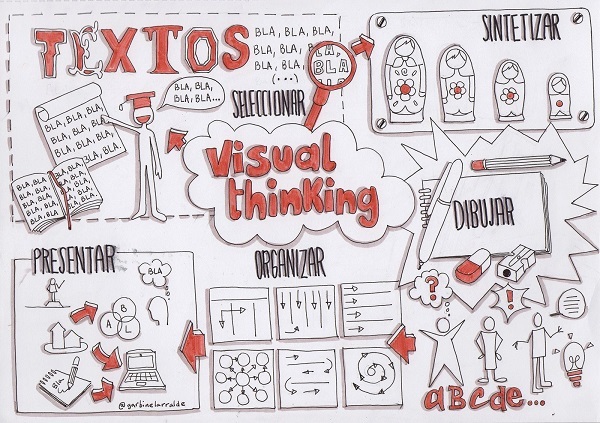
Definition and Importance
Visual Thinking is a cognitive process that involves using visual elements to represent and process information. This method leverages the brain’s ability to recognize patterns, shapes, and colors, making complex ideas easier to understand and communicate. Visual Thinking is crucial in various fields, including education, business, and design, as it enhances creativity, problem-solving, and collaboration.
Historical Background
The concept of Visual Thinking dates back to ancient times when early humans used cave paintings and symbols to convey messages and ideas. Over the centuries, this method evolved, with notable contributions from figures like Leonardo da Vinci, who used sketches to explore scientific concepts. In the modern era, Visual Thinking gained prominence through the works of Rudolf Arnheim and Tony Buzan, who emphasized the importance of visual elements in cognitive processes.
Importance in Modern Education
In classrooms, Visual Thinking has become a critical tool. Teachers use it to explain complex ideas, while students employ it to better understand and retain information. By incorporating Visual Thinking Strategies into the curriculum, educators can foster an environment that not only promotes learning but also encourages creativity and innovation.
Key Concepts
Visual Thinking encompasses several key concepts, including:
- Visualization: The process of creating mental images to represent information.
- Mind Mapping: A technique that involves creating diagrams to organize and connect ideas.
- Sketching and Drawing: Using simple drawings to convey complex concepts.
- Infographics: Visual representations of data and information.
These concepts form the foundation of Visual Thinking, enabling individuals to process and communicate information more effectively.
Visual Thinking Strategies
Visual Thinking Strategies (VTS) are designed to guide individuals in using visuals to enhance understanding and communication. These strategies encompass a range of techniques and tools that can be applied across various fields
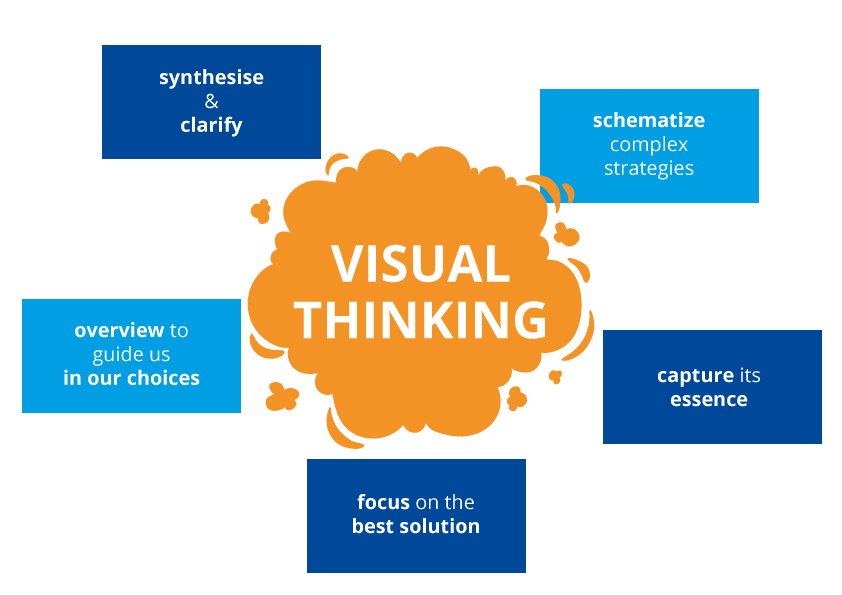
Techniques and Tools
Several techniques and tools can enhance Visual Thinking, including:
- Mind Mapping: Creating diagrams that connect ideas and concepts.
- Sketching and Drawing: Using simple drawings to represent information.
- Infographics: Visual representations of data and information.
- Storyboarding: Creating a sequence of images to tell a story or explain a process.
- Concept Mapping: Diagramming relationships between concepts.
These techniques can be applied in various contexts, from brainstorming sessions to presentations, to enhance understanding and communication.
Applications in Different Fields
Visual Thinking is applicable in numerous fields, including:
- Business and Management: Enhancing strategic planning, problem-solving, and communication.
- Education and Training: Improving teaching methods and student engagement.
- Design and Creativity: Facilitating the creative process and idea generation.
- Healthcare: Assisting in patient education and medical research.
By integrating Visual Thinking into daily practices, organizations can improve collaboration, innovation, and problem-solving capabilities.
Case Studies
Several case studies highlight the effectiveness of Visual Thinking:
- IDEO: The design firm uses Visual Thinking to brainstorm and develop innovative products.
- Google: The tech giant employs Visual Thinking in its design sprints to solve complex problems quickly.
- Stanford d.school: The institute integrates Visual Thinking into its curriculum to foster creativity and innovation.
Visual Learning and Its Impact
Visual Learning, a subset of Visual Thinking, focuses specifically on how individuals learn through visual means. It plays a crucial role in education by enhancing comprehension and encouraging creativity

Visual Learning vs. Traditional Learning
Visual Learning differs from traditional learning methods by emphasizing visual elements over text-based information. This approach caters to visual learners, who make up a significant portion of the population, and can enhance understanding and retention for all students.
Benefits of Visual Learning
Visual Learning offers several benefits, including:
- Improved Comprehension: Visual elements can make complex concepts easier to understand.
- Enhanced Retention: Information presented visually is often easier to remember.
- Increased Engagement: Visual elements can capture students’ attention and make learning more enjoyable.
- Better Problem-Solving: Visualizing problems and solutions can help students identify patterns and connections.
Implementing Visual Learning in Education
Educators can implement Visual Learning in various ways, including:
- Using Visual Aids: helps students grasp complex concepts by breaking them down into manageable, visual components. This method is particularly effective for visual learners, who make up a significant portion of the student population. By catering to their learning style, educators can improve overall comprehension and academic performance. Incorporating charts, diagrams, and infographics into lessons.
- Encouraging Sketching and Drawing: Allowing students to create visual representations of concepts.
- Integrating Technology: Using digital tools and software to create interactive visual elements.
- Promoting Mind Mapping: Encouraging students to use mind maps to organize and connect ideas. By allowing students to express themselves through visuals, educators can encourage out-of-the-box thinking and innovation. This creative approach not only makes learning more enjoyable but also prepares students for future challenges in a rapidly changing world.
4 Common Types of Visual Thinking
Visual thinking is not simply about drawing pictures or creating diagrams, but it also includes many different types of expression. Below are the 4 most common types of visual thinking to help you better understand how to apply this method in work and life:
Sketch
Sketching is a quick and simple way to express ideas. With just a pen and paper, you can sketch the thoughts and images you want to convey. This is the first step to transfer ideas from the brain to the outside, thereby helping you easily visualize and adjust to reality. Visual thinking often has many examples of how to use sketches to design, plan products, take notes, etc. creatively.
Diagram
Diagrams are a useful tool in presenting relationships between elements. Use shapes, arrows, labels, etc. to represent processes, workflows or cause-and-effect relationships. A clear diagram can replace a long page of complicated information. Visual thinking applications in marketing often use diagrams to explain marketing strategies or processes.
Chart
Charts are a popular way to represent data through images. Instead of listing numbers, charts help viewers easily compare and identify trends. Types of charts such as column charts, line charts or pie charts are often used in marketing data analysis, thereby helping to make more accurate decisions.
Tables
Tables are a way to present information in a structured way, allowing viewers to follow data visually and easily to understand. In reports, plans, and marketing strategies, tables are also often used to summarize important information more clearly and quickly.
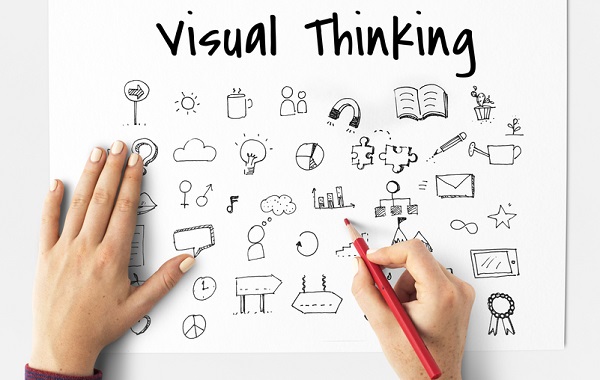
Metaphors
Metaphors are an interesting form of visual thinking that helps users connect two different ideas using images to clarify an abstract concept. This method helps information become more “soul”, lively and closer to the viewer. It also stimulates imagination and helps people easily accept the ideas and content presented.
Combo
Combining multiple types of visual thinking is a comprehensive approach that helps you express complex ideas or information. A marketing plan can use diagrams, charts or tables for the most vivid and easy-to-understand presentation.
The Science Behind Visual Thinking
Cognitive Processes
Visual Thinking engages various cognitive processes, including perception, memory, and reasoning. When we visualize information, our brain processes it through the visual cortex, which is responsible for interpreting visual stimuli. This process enhances our ability to understand and retain information, as visual elements are often easier to remember than text alone.
Brain Function and Visual Thinking
The brain’s structure plays a significant role in Visual Thinking. The right hemisphere, which is associated with creativity and spatial awareness, is particularly active during visual tasks. This hemisphere’s involvement explains why Visual Thinking can enhance creative problem-solving and innovation. Additionally, the brain’s ability to recognize patterns and shapes quickly makes visual elements an effective tool for processing complex information.
Benefits of Visual Thinking
Visual Thinking offers numerous benefits, including:
- Enhanced Creativity: Visual elements stimulate the brain’s creative centers, leading to more innovative ideas.
- Improved Problem-Solving: Visualizing problems and solutions helps individuals identify patterns and connections that may not be apparent through text alone.
- Better Communication: Visual elements can convey complex ideas more clearly and concisely, improving understanding and collaboration.
- Increased Retention: Information presented visually is often easier to remember, leading to better retention and recall.

Application of Visual Thinking in Marketing
Visual thinking in marketing not only helps present data and strategies vividly but also helps promote creativity. By turning complex ideas into images, marketers can easily communicate with team members, customers and partners. Besides, converting complex data into vivid images such as dashboards, visual reports, etc. visual thinking helps marketers analyze customer data, grasp market trends, and monitor campaign performance in an easy-to-understand way.
This helps them have a clearer overview of the current situation and make faster, more accurate decisions. Using visual thinking in the marketing process also helps create Creative Advertising campaigns that are easier to understand and attract viewers. In fact, it can be seen that an eye-catching infographic will be much more effective than a lengthy but difficult-to-understand article.
Visual thinking is also an effective support tool in product creation and development. Through sketching, process mapping and product simulation, creatives and designers will easily exchange ideas and collaborate with each other. Especially clearly shaping products and services, ensuring they fit the needs and desires of customers right from the beginning.
Difference between Visual Thinking and Design Thinking
Although both visual thinking and design thinking are aimed at creativity and problem solving, they have distinct differences. Visual thinking focuses on using images to think and communicate ideas, while design thinking is a creative process that includes steps such as empathizing, identifying problems, generating ideas, searching solutions and testing.
Simply put, Visual thinking is part of the design thinking process. In the design thinking steps, visual thinking is often used to simulate, sketch and test ideas quickly to help the design team come up with the most optimal solutions.
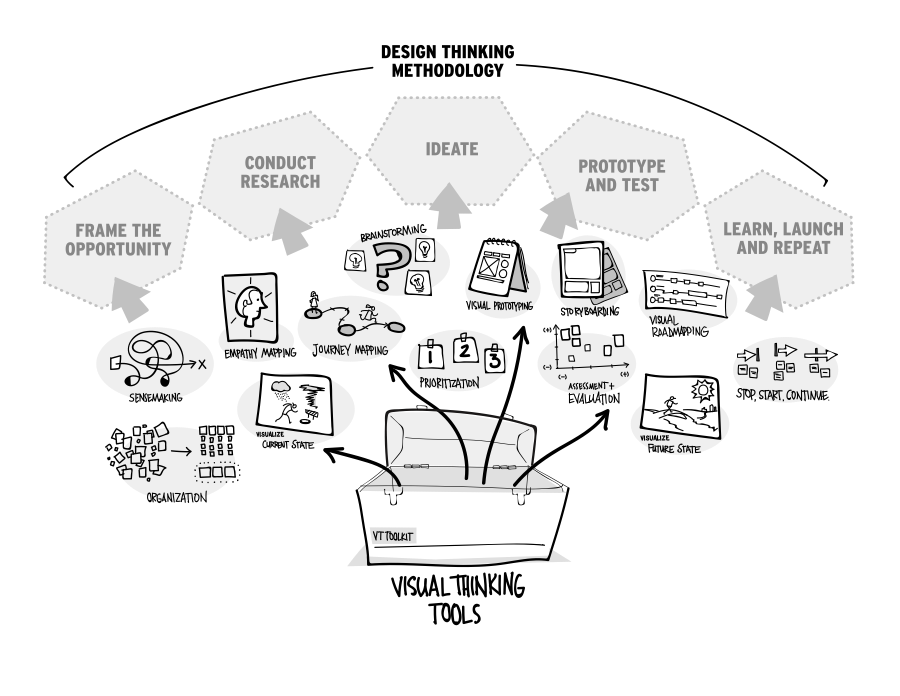
Practical Applications of Visual Thinking
Business and Management
In business and management, Visual Thinking can enhance strategic planning, problem-solving, and communication. Techniques like mind mapping and storyboarding can help teams brainstorm ideas, develop strategies, and communicate plans more effectively.
Education and Training
Visual Thinking can transform education and training by making learning more engaging and effective. Educators can use visual aids, encourage sketching and drawing, and integrate technology to enhance students’ understanding and retention.
Personal Development
Visual Thinking can also benefit personal development by improving creativity, problem-solving, and communication skills. Individuals can use techniques like mind mapping and sketching to organize their thoughts, generate ideas, and communicate more effectively.
Challenges and Limitations of Visual Thinking
Common Misconceptions
Several misconceptions about Visual Thinking can hinder its adoption, including:
- It’s Only for Artists: Visual Thinking is not limited to artists; anyone can use visual elements to enhance understanding and communication.
- It’s Time-Consuming: While creating visual elements can take time, the benefits often outweigh the effort.
- It’s Not Effective for Complex Concepts: Visual Thinking can simplify complex concepts by breaking them down into visual elements.
Potential Drawbacks
Despite its benefits, Visual Thinking has some potential drawbacks, including:
- Over-Reliance on Visuals: Relying too heavily on visual elements can lead to a lack of depth in understanding.
- Accessibility Issues: Visual elements may not be accessible to individuals with visual impairments.
- Misinterpretation: Visual elements can be misinterpreted if not designed clearly and accurately.
Overcoming Challenges
To overcome these challenges, individuals and organizations can:
- Balance Visuals with Text: Use a combination of visual and text-based information to ensure depth and clarity.
- Ensure Accessibility: Design visual elements with accessibility in mind, using alternative text and other tools.
- Focus on Clarity: Create clear and accurate visual elements to minimize misinterpretation.
Future of Visual Thinking
Emerging Trends
Several emerging trends are shaping the future of Visual Thinking, including:
- Increased Use of Technology: Digital tools and software are making it easier to create and share visual elements.
- Integration with AI: Artificial intelligence is enhancing Visual Thinking by automating the creation of visual elements and providing new insights.
- Growing Emphasis on Creativity: As creativity becomes more valued in various fields, Visual Thinking is gaining prominence as a tool for innovation.
Technological Advancements
Technological advancements are driving the evolution of Visual Thinking, with new tools and software making it easier to create and share visual elements. Virtual reality and augmented reality are also opening new possibilities for Visual Thinking, allowing individuals to interact with visual elements in immersive environments.
Predictions and Opportunities
The future of Visual Thinking holds numerous opportunities, including:
- Enhanced Collaboration: Visual Thinking can facilitate collaboration by making it easier to share and communicate ideas.
- Improved Education: Visual Thinking can transform education by making learning more engaging and effective.
- Increased Innovation: Visual Thinking can drive innovation by enhancing creativity and problem-solving.
Download eBook Visual Thinking
If you want to learn more about visual thinking, you can start with the book Visual Thinking PDF. The content inside will include basic concepts and specific practice exercises to help you get acquainted and apply visual thinking to your work and daily life.
Google Drive: Download eBook Visual Thinking
Direct: Download eBook Visual Thinking
Conclusion
Visual Thinking is a powerful cognitive process that uses visual elements to represent and process information. It enhances creativity, problem-solving, and communication by leveraging the brain’s ability to recognize patterns and shapes. Visual Thinking is applicable in various fields, including business, education, and personal development, and offers numerous benefits, such as improved comprehension, retention, and engagement.
As we move towards a more visually oriented world, the importance of Visual Thinking continues to grow. By understanding and applying Visual Thinking strategies, individuals and organizations can enhance their creativity, problem-solving, and communication skills. Whether you’re a student, educator, business professional, or simply someone looking to improve your cognitive abilities, Visual Thinking offers valuable tools and techniques to help you succeed.
FAQs
What is Visual Thinking?
Visual Thinking is a cognitive process that involves using visual elements to represent and process information. This method leverages the brain’s ability to recognize patterns, shapes, and colors, making complex ideas easier to understand and communicate.
How can Visual Thinking improve problem-solving?
Visual Thinking enhances problem-solving by allowing individuals to visualize problems and solutions. This process helps identify patterns and connections that may not be apparent through text alone, leading to more innovative and effective solutions.
What are some common Visual Thinking techniques?
Common Visual Thinking techniques include mind mapping, sketching and drawing, infographics, storyboarding, and concept mapping. These techniques help organize and communicate ideas more effectively.
How does Visual Thinking benefit businesses?
In business, Visual Thinking can enhance strategic planning, problem-solving, and communication. Techniques like mind mapping and storyboarding help teams brainstorm ideas, develop strategies, and communicate plans more effectively, leading to better decision-making and innovation.
Can Visual Thinking be applied in education?
Yes, Visual Thinking can be applied in education to make learning more engaging and effective. Educators can use visual aids, encourage sketching and drawing, and integrate technology to enhance students’ understanding and retention.
What are the challenges of Visual Thinking?
Challenges of Visual Thinking include misconceptions that it’s only for artists or that it’s time-consuming, potential drawbacks like over-reliance on visuals and accessibility issues, and the risk of misinterpretation. These challenges can be overcome by balancing visuals with text, ensuring accessibility, and focusing on clarity.
How can Visual Thinking Strategies be applied in the classroom?
Teachers can use Visual Thinking Strategies to present complex concepts in a visual format, making them easier for students to understand. Techniques like mind mapping and storyboarding are particularly effective in educational settings.
What are the benefits of Visual Learning?
Visual Learning enhances comprehension, fosters creativity, and caters to diverse learning styles. By presenting information visually, educators can improve students’ understanding and engagement.
How does Visual Thinking improve workplace productivity?
Visual Thinking streamlines processes and enhances communication by allowing teams to visualize workflows, set goals, and track progress. This approach leads to increased efficiency and collaboration.
What are some common Visual Thinking tools?
Popular Visual Thinking tools include mind maps, concept maps, storyboards, and flowcharts. These tools help individuals organize thoughts and present information in a clear, visual manner.
What are the future trends in Visual Thinking?
Emerging technologies like VR and AR are expanding the possibilities for Visual Thinking. These advancements offer immersive experiences that enhance understanding and engagement.
Comment Policy: We truly value your comments and appreciate the time you take to share your thoughts and feedback with us.
Note: Comments that are identified as spam or purely promotional will be removed.
To enhance your commenting experience, consider creating a Gravatar account. By adding an avatar and using the same e-mail here, your comments will feature a unique and recognizable avatar, making it easier for other members to identify you.
Please use a valid e-mail address so you can receive notifications when your comments receive replies.
